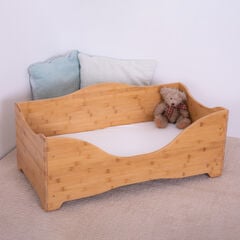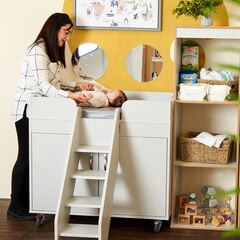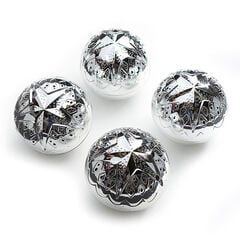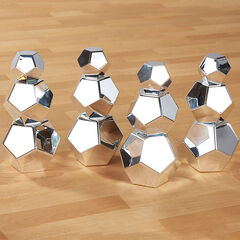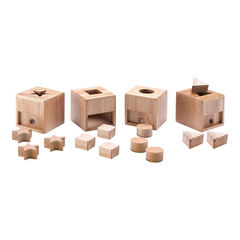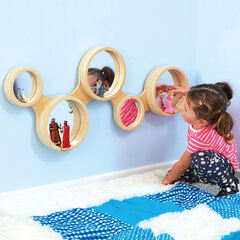Although we know that the adult is the most important feature of any learning environment, this blog will share some other ideas for us to consider when creating a baby room. It will focus on key elements that can impact a child’s learning and development. These include layout, colours, furniture, learning areas, and resources.
What is a baby room?
The baby room in a nursery setting is where the journey begins – a space where basic needs, comfort, stimulation, meaningful interactions, and safety intertwine. With extra funded hours now provided for our youngest children, more babies will have the opportunity to attend a range of settings. By creating a home from home environment, this will help children with transition, giving them a nurturing experience.
The baby room in a nursery setting not only caters for babies, but can often include children up to the age of two. Making sure that the furniture and resources are purposeful and meet the needs of all children often takes a lot of time and thought.
Why is the layout of a baby room important?
As early years practitioners, an important part of our job is creating a nurturing environment—a space that makes children feel happy, safe, settled, and gives them a sense of belonging.
The layout of the room can impact how the children interact and learn. A room that is too busy or cluttered can be overstimulating, overwhelming, and detract from the learning opportunities. It can also restrict the development of gross motor skills such as crawling, cruising, or walking.
Since babies spend a considerable portion of their day in this space, prioritising safety and creating a nurturing environment is crucial. The room should exude warmth and inclusivity while remaining functional and organised.
What areas should I consider when setting up learning areas in a baby room?
Setting up mini-learning areas within the room can help us cater for our children’s different needs while creating an engaging environment. Consider the following areas:
- Quiet Area
- Sensory
- Construction
- Small World
- Creative
- Messy Play
- Home Corner
- Floor Space for Physical Development
Quiet Area
Is there a comfortable place where children can independently rest or nap? A space that can double up as a cosy nook where children can take time out to process their thoughts, share a book, recharge, or play independently.
Sensory Space
Have you included a sensory area? Somewhere children can interact with tactile materials like fabrics and interesting objects with different textures and weights. You might consider adding contrasting bold patterns and colours e.g. red, white and black, to develop visual stimulation and focus for younger babies.
Construction
Is there provision for varied construction activities? Construction activities can greatly enhance motor skills and cognitive development. Create a space with soft building blocks and simple stacking toys. These hands-on activities encourage babies to explore cause and effect, develop hand-eye coordination, and start early problem-solving. As children grow, they’ll enjoy the challenge of creating and dismantling structures, developing both creativity and fine motor skills in an engaging way.
Small World Play
Why not include chunky miniatures of everyday objects (e.g. mini me’s made with images on wooden blocks), animals, and simple landscapes, providing a tactile and visual experience? Soft, safe materials and baby-friendly figures and dolls allow for safe exploration, the acting out of familiar situations and storytelling.
Creative Area
Setting up a creative space is a great way to support development. Fill this area with soft, sensory toys, interactive wall art and colourful floor mats. Include items like mirrors, different textured materials and simple musical instruments to engage their senses and curiosity. As children grow and develop, update the space with new activities to keep them learning and exploring. This all helps to instill a love for creativity and discovery early on.
Messy Play
Incorporating a messy play area into your baby room is a fantastic way to support sensory development and creativity. Having a safe space with easy to clean surfaces e.g. a tuff tray or crawl up tables etc allow young children to explore and discover using their senses.
Provide opportunities such as:
-Materials like washable paints to walk or place their hands in.
-Shredded paper or sensory bins (trays filled with different textures) for the children to observe.
-Edible paint (made with yoghurt and food colouring)
– Home made playdough
Please ensure that risk assessments are carried out before introducing children to the above activities.
Home Corner
For many, having a home corner is important. The children see this as a familiar, welcoming space and are often able to relate to it and model the behaviour they have encountered.
Physical Development
Consider the floor space. Is there enough room for gross motor activities such as tummy time, baby gyms, rolling, crawling, or climbing? Can the children explore movement in a range of ways that are consistent with their developmental capabilities?

How do you personalise the space and learning areas?
Personalise the space and learning areas based on your understanding of the children in your setting. There is no one-size-fits-all approach; it’s about identifying what your children need to grow, develop, flourish, and learn. Consider how the environment reflects the children’s needs, interests, ages, and next steps.
Why is it important to have safe resources and toys in a nursery setting?
Safety and risk assessments are major considerations for all children, especially babies. Ensure that everything is tested and developmentally aligned for the children. This plays a huge role when setting up a baby room. Children playing with a toy at home will differ from multiple children using it daily. Resources need to be well-made, versatile, and as open-ended as possible. How a 6 month old baby interacts with a resource may be significantly different from that of a 10-month-old, but it may still appeal to the children and build on their developmental skills in different ways.
What type of resources are suitable for the baby room?
Babies are born with an innate sense of curiosity. When creating environments, we must provide resources that nurture this desire. Do you have objects or items in the room that provide a richness of textures, sounds, and sights that babies can safely explore and investigate?
Shake, rattle, and roll
Items such as wooden shakers or treasure cylinders not only captivate the interests of the children as they observe the contents within but offer opportunities for them to explore sounds and movements. Open-ended resources provide flexibility and freedom, encouraging children to investigate and build upon emerging developmental skills. Objects, such as rattles and shakers, fascinate babies. They enjoy the sounds they make and experiment by rolling, shaking, stacking or banging them together. Place different items in a treasure basket to create an engaging learning experience where children can use their senses to explore.
Posting Pots
Posting posts are another great resource that can be used in various ways. For example, a baby might start by holding and exploring the shapes before determining if they can be posted, rattled, or removed from the containers. Alternatively, they may enjoy watching the object disappear as the adult posts the shape into the hole. As children develop, their movements and hand-eye coordination will become more refined. As their skills develop, they can extend their learning further by matching and posting the shapes into the correct box by themselves.

Reflective materials and mirrors
Resources with different finishes, such as metallic surfaces, not only offers babies different materials to explore but are great for investigating different textures, shapes, and sizes. Children can experiment to see which ones roll or stack.
Reflective materials encourage babies to gaze at their image and can be placed around them during tummy or floor time, encouraging them to reach out and grasp. Alternatively, the metallic donuts and threading beads can be hung to make a mobile or attached to a baby gym.
Add mirrors to your provision to engage children in exploration and stimulate curiosity. Provide hand-held mirrors or place wall mirrors at child height to encourage babies to explore facial expressions, gestures, and differences. Mirrors with rims are ideal for placing objects on, encouraging babies to move to retrieve the object. Mirrors also help to promote self-awareness and a sense of self in young children.
Resources to support physical development
As babies start to experiment with different types of movements, why not add different surfaces at various levels for crawling and clambering on. Soft play equipment is perfect for safe exploration and development of skills.

Furniture and furnishings
What furniture do I need in the baby room?
Think about furniture that supports the practitioner while meeting the children’s basic comfort and needs. These can include:
- Providing seating for the adults. For example, do they have somewhere comfortable to sit when feeding or comforting a child?
- Have you got storage that allows easy access to nappies, wipes, and other essential equipment?
- Consider incorporating furniture that promotes independence for the younger children while also considering the physical needs of staff. This could include changing mats available at different heights or walk-up changing tables that the children can access with support when ready.
Other considerations for furniture
When thinking about the furniture in a baby room, consider the practical aspects and the learning opportunities it can offer. Things to think about may include:
- What is in the eyeline of non-mobile babies? Can they see what their surroundings offer? As practitioners, we must try hard to see the environment from the child’s perspective. Get down to the children’s level to observe the room as they will see it.
- Select furniture that can be used to create different spaces and utilised in a range of ways.
- Can children self-access and easily find resources, making their own choices about what to explore and play with? Are they able to see and reach what is on offer?
- Does the furniture promote physical development? Is it safe for the children to pull themselves up or cruise along?

Soft Furnishings
Many nurseries opt to use neutral colours in the baby room as this provides a calmer environment. Coloured or patterned fabrics, such as cushions, can be incorporated for the children to explore without it being overstimulating.
Babies can spend a lot of time on the floor. Consider the surfaces they sit, kneel, crawl, or walk upon. They need to be varied, welcoming, comfortable, safe and durable.
What about room lighting?
Make the most of natural light and consider the room’s temperature. Additional soft lighting, such as lamps or glow resources, can alter the ambiance and be an alternative to bright, harsh lights. Lighting can serve as a cue for rest periods or offer opportunities for exploration.
As this blog highlights, there are many things to consider when setting up a baby room in a nursery setting. Hopefully, this blog will give you a starting point with some useful ideas.
Most of all, we must remember to immerse our children and staff in a space where they will feel nurtured, valued, and supported by providing a safe environment with appropriate resources.
After all, research shows the importance of the first five years, so let’s grasp every opportunity to give our children a strong foundation with which to build the future they deserve.
Written by Michelle Reid. Michelle has over 20 years of experience working as a nursery nurse and qualified teacher in the Early Years and Primary sector.















